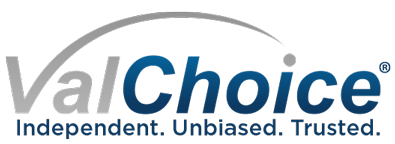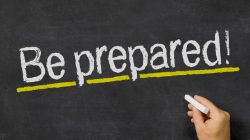Were you prepared for this pandemic? You’re not alone. Nobody was. Hopefully we all learned a lesson. Nearly one and a half years into the pandemic, and September being National Preparedness Month (NPM), there’s no time to start preparing like now.
The 2020 theme for National Preparedness Month is: Prepare to Protect. Preparing for disasters is protecting everyone you love. In support of this NPM theme, ValChoice has put together 12 easy steps to make sure your insurance coverage is ready for a disaster. Follow these steps to be prepared for whatever comes your way.
1) How good is my insurance company about paying claims?
First, make sure you know how good your current insurance is. Interestingly, most people think their insurance company is good, even though many haven’t filed a claim. In reality, people outgrow their insurance companies. For example, you may have chosen a price leader back when you first got insurance and every penny counted. Will that company stand behind you now that you have assets to protect? Find out how good your insurance companies are by clicking the buttons below.
For more information on this topic, read our blog post How good is my insurer about paying insurance claims?
2) Hurricane Insurance
Hurricane insurance isn’t necessarily a different type of insurance. Depending on where you live and who your homeowner’s insurance company is, hurricane insurance can be part of your homeowner’s policy. The difference from the traditional homeowner’s policy is that the deductible may be larger. Also, the deductible is calculated differently. Importantly, the increase in the deductible amount is often significant.
Homeowners insurance policies typically have a dollar deductible. $500 and $1,000 are a common deductible amount. No matter how much damage you have with a dollar deductible, you pay the amount of the deductible.
However, hurricane deductibles are based on a percentage of the insured value of the home. For example, if the insured value of your home is $500,000, here’s what you would owe. With a 2% deductible you would pay the first $10,000. With a 5% deductible, you pay the first $25,000. In this example, the difference the homeowner would owe could be as much as $24,500.
For more information on hurricane insurance, see the post titled “How to Get Hurricane Insurance Without Getting Blown Away“.
3) Tornado Preparation and Insurance
Tornado warnings typically come with only one day of warning. That’s not enough time to properly prepare. Don’t wait. Start preparing now. Make sure your home and property are prepared by taking the following steps:
- If you live in an area that floods, have comprehensive insurance on your cars and flood insurance on your home.
- Have a complete list of contents for your home. The list should include images and value estimates.
- Know the condition of your roof. Does it have known problems that could cause it to leak during the next storm?
For more information on preparing for a tornado, read the post “How do I prepare for a tornado warning?”
4) Wildfires
Anyone reading about protecting themselves from wildfires probably lives in an area where wildfires are a risk. That means you need to make sure yo have good insurance coverage. Here are a few important considerations:
- Make sure you have adequate coverage. Wildfires can destroy everything. If you’re underinsured, the insurance company will not pay more than the amount of coverage you purchased.
- Adequate coverage to rebuild the home
- Coverage for your belongings is separate from rebuilding the structure of the home
- Adequate living expense. Temporary living could be on a relatively long-term basis since contractors will likely be busy after a major wildfire. Make sure your allowance for temporary housing is sufficient.
- Be sure to buy insurance from a good company. We publish the best insurance companies in every state.
For more information on preparing for wildfires, read the post “How do I protect my home from wildfires near me?”
5) Floods
There are many questions people have about flood insurance. Here are a few:
- My homeowners insurance includes water damage. Does that mean I don’t need flood insurance? No.
- I have both homeowners insurance and flood insurance. Does my homeowners insurance deductible apply to flood insurance? No.
- If I get flood insurance, does that need I don’t need homeowners insurance? No.
For more details about flood insurance, read the post “10 Facts About Flood Insurance, Without Drowning in Details.”
6) Umbrella Insurance
$500,000 in liquid assets is typically the threshold for buying umbrella insurance. If your liability limit isn’t $500,00, use your limit to assess the level of liquid assets that determines if you need umbrella insurance. You can do this easily by comparing your liability limit to your liquid assets. The insurance policy limit needs to be equal to or greater than the liquid assets.
Other than needing more protection, there’s another reason. Buying an umbrella policy holds the insurance company responsible for a larger sum of money. In this case, your insurance company is motivated to defend a lawsuit. Now the business decision the insurance company makes is likely to be aligned with what you need.
For more information on umbrella insurance, read the post titled “Should I buy umbrella insurance?”
7) House Fires
Home fires are typically caused by the homeowner or the renter. Here’s a breakdown of the most common causes for a house fire:
- Cooking, 56%
- Heating, 16%
- Electrical malfunction, 9%
- Other forms of carelessness, 8%
- Open flame, 6%
- Intentional, 5%
Routine maintenance goes a long way in avoiding house fires. For more information on protecting yourself from home fires, read the post “Home fires: what can I do to avoid a house fire?”
8) Lightning Protection
Protection in a lightning storm includes both protecting yourself and your home. Starting with protecting yourself, here are a few key points:
- Go inside. Make sure you are inside a solid structure or an automobile with a hard top.
- Don’t ever be the tallest object around, or close to the tallest object.
- Avoid tall objects or metal objects. Don’t take shelter under a tree or near a metal fence.
- Inside your home, stay away from anything connected with wires or piping (TVs, lights, appliances, faucets, etc.).
Next, protecting your home and possessions from damage from a lightning strike varies from simple and inexpensive to elaborate and expensive. Below is a list of the simple and inexpensive actions you can take.
- Install UL listed surge protectors. These need to be specially designed for electrical strikes. Don’t use power strips as protective devices. Most are not designed for reliable lightning strike protection.
- Unplug expensive electronics. If you are going to be gone for a while, unplug the computer, TV, etc. before you leave. If a storm is approaching, unplug the devices temporarily. House wiring is a direct path from the lightning strike to these devices. If they are unplugged, that is the best form of surge protection.
For more information on how to prepare for a lightning storm, read the post “Does my home need a lightning rod to protect from lightning strikes?”
9) Earthquake Insurance
Most homeowners insurance policies do not cover earthquakes. Nevertheless, earthquakes often cause significant damage to property. This may lead you to ask, why aren’t they covered. Here’s why. Earthquakes are very specific in where they occur. Only people in those areas need the insurance, not everyone. Therefore, having earthquake insurance as a separate type of coverage makes sense.
It’s important for consumers to consider how they would manage the costs of recovering from an earthquake should they be impacted. For example, can they afford to repair or rebuild and how likely is the home or business to be seriously damaged? Brick homes, wood-frame homes with crawl spaces and multi-story homes are the most likely to suffer serious damage from an earthquake. Consumers should also know that most companies won’t sell new earthquake insurance policies for 30-60 days after a quake due to the expectation of aftershocks.
For more information on earthquake insurance, read the post “Do I need earthquake insurance? If so, how much?”
10) Ice Dams and Roof Leaks
Inadequate insulation is the most common cause of ice dams. Homeowners insurance typically will cover damage from ice dams. However, be sure to check your insurance policy. Look for exclusions that would prevent you from being covered. You will of course be responsible for the deductible amount specified in your insurance policy.
For more information on ice dams and home insurance, read the post titled “Will that damn ice dam cause my roof to leak?”
11) Snowstorms
There are a number of steps to take for preparing your family, your home and your car. A few key items include:
- Have a plan for communicating. You’re family may be in different locations when the storm hits. Know how you will reach each other.
- Charge cell phone batteries ahead of time.
- Pack an emergency kit with everything needed to survive a multi-day power outage.
- Have plenty of blankets to keep you warm
- Make sure an alternative heat sources that you can rely on is available in case the power goes out.
- Have good tires with plenty of traction
- Always carry an emergency kit
For more details on how to prepare for a snowstorm, read the post “There’s a snowstorm coming. Are you ready?”
12) Winter Driving
Watch out. Icy roads are approaching. Hence, now is a good time to make sure you have proper coverage. Check your liability insurance, collision insurance, comprehensive insurance and both underinsured and uninsured motorist insurance. Get all the details in the post titled “Types of Car Insurance You Need for Fall and Winter Driving.”
Bonus Point) Buy Insurance From the Best Insurance Companies
Once disaster strikes, or even as it approaches in the case of storms, changing insurance is not an option. As the size of the insurance claim increases, the likelihood of a satisfactory experience decreases. Make sure you’re getting the protection you’re paying for. We make it easy. ValChoice lists the best companies in every state. Just click the buttons below to find the best auto insurance companies and the best home insurance companies.
The question on nearly everyone’s mind when it comes to buying insurance is, “what should it cost?” ValChoice helps consumers find a fair price with our car insurance calculator and homeowners insurance calculator. Click the buttons below to get an estimate for your insurance.
More information about National Preparedness Month can be found at Ready.gov.


Comments are closed.